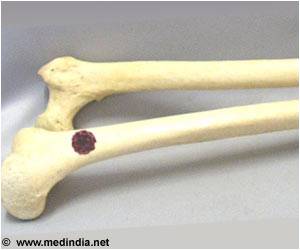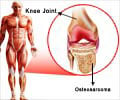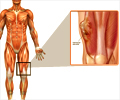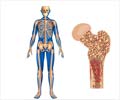What is Bone Cancer?
Bone cancer is a malignant tumor that affects bones.
A malignant tumor is one that spreads within the affected part as well as to other organs. If it is not treated completely, it has the chance of recurring. This is in contrast to a benign tumor which remains localized to the affected part.

There are two types of bone cancer depending on the origin of the cancer:
Secondary bone cancer is cancer that originates from other sites like the breast, lung or prostate and then spreads to the bone. Since the spread takes place in later stages of the cancer, secondary bone cancer is difficult to treat.
Primary bone cancer originates from the cells of the bone. Since the bone is composed of different types of cells, there are several types of primary bone cancers which include the following:
- Osteosarcoma or osteogenic sarcoma, which arises from the hard bony tissue
- Chondrosarcoma, which arises from cartilage at the ends of bones and in joints
- Ewing Sarcoma Family of Tumors (ESFTs), which may arise from the bony tissues as well as the soft tissues like muscle, fat, fibrous tissues and blood vessels.
Other extremely rare primary bone cancers include:
- Malignant fibrous histiocytoma
- Fibrosarcoma
- Giant cell tumor of bone
Secondary bone cancers are more common than primary bone cancers.
In addition, cancers can also develop from bone marrow, the inner part of the bone that produces blood cells. Bone marrow cancers include leukemia, lymphoma and multiple myeloma. However, these cancers are usually classified as blood cancers rather than bone cancers.
Bone cancer spreads either locally to adjacent tissues, or to distant sites via blood or lymphatics. Bone cancer commonly spreads to the lungs.
What are the Causes of Bone Cancer?
As is the case with most other cancers, the exact cause of primary bone cancer is not known. Some factors that increase the risk for cancer include the following:
- Exposure to radiation treatment especially during childhood
- Exposure to anticancer drugs belonging to the group of alkylating agents
- Presence of genetic conditions like hereditary retinoblastoma, Paget disease, Diamond-Blackfan anemia, Li-Fraumeni syndrome, Rothmund-Thomson syndrome, Bloom syndrome and Werner syndrome.
What are the Symptoms and Signs of Bone Cancer?
Symptoms associated with bone cancer are:
- Bone pain: The pain initially gets worse at night or with activity, but may be constant in later stages
- Swelling over a bone: The swelling may or may not be obvious

- Increased fragility of bone: The bone may get fractured easily
- Other features normally associated with cancer like fatigue, fever and weight loss
The site of the cancer varies according to the type. Osteosarcoma is usually seen in teenagers and commonly affects the knee or upper arm. Chondrosarcoma usually affects people over the age of 40 years. It commonly affects the pelvis, upper leg and shoulder joint. Ewing sarcoma is a rare bone cancer that affects children and youngsters below the age of 19 years. It occurs along the spinal column, pelvis, legs and arms.
How to Diagnose Bone Cancer?
Diagnosis of bone cancer is based on:
- History obtained from the patient and the family
- Physical examination of the patient
- Radiological tests which include:
- X-ray: X-ray may show the presence of an abnormality associated with the bone
- Bone Scan: In this procedure, a small amount of radiological substance is injected which accumulates in the tumor. The images are then obtained using a scanner
- CT scan and MRI: These tests provide detailed imaging of the bone cancer

- Positron Emission Tomography Scan (PET scan): In this scan, glucose attached to a radioactive substance is injected into the blood. Since cancers need more glucose, the radioactive – labeled glucose gets accumulated in the cancer, which is detected using a scanner. A PET scan is also useful to note if the cancer has spread to other sites
- Biopsy of the tissue, which may be obtained using a needle or via a minor surgical procedure
- Blood tests: The level of the enzyme alkaline phosphatase is increased in bone cancer. This test is not specific for bone cancer and increase in alkaline phosphatase may occur in other conditions as well
Diagnostic tests also help to stage the cancer or in other words study the extent of the cancer. Staging helps to plan on the treatment and also the likely outcome.
How do you Treat Bone Cancer?
Cancer treatments are of two types – curative and palliative. Early cancers are usually treated aggressively especially when there is a possibility of the cancer being cured. On the other hand, late-stage cancers are usually treated with palliative treatment, where treatment is administered mainly to relieve the patient of symptoms of the cancer.
Bone cancer is treated by one or more of the following modalities:
- Surgery: A localized bone cancer is surgically removed along with some healthy tissue around it. If the cancer is on a limb, efforts are made to preserve as much of the limb as possible, though amputation may be sometimes required. Plastic surgery or prosthetic limb may be necessary after the removal.

- Cryosurgery: It is a procedure where the cancer cells are frozen and thereby killed.
- Chemotherapy / Radiotherapy: These are often used after surgery to kill any cancerous cells that may persist in the body and thereby prevent recurrence of the cancer. They are sometimes administered before surgery to shrink the tumor. Chemotherapy is not used to treat chondrosarcoma.
- Targeted therapy: It acts on molecules or genetic material within cancerous cells. Denosumab is a type of targeted therapy used to treat giant cell tumors.
Prevention and Health Tips
Many times, the cause of bone cancer is not known. Therefore, there is not much in terms of prevention of bone cancer. However, some standard tips are useful to prevent all types of cancer:
- Adopt a healthy lifestyle with adequate exercise and plenty of fruits and vegetables in the diet
- If you have Paget’s disease or any other predisposing condition, get yourself regularly checked for cancer
- Stop smoking and reduce alcohol intake
- Since stress can predispose to cancer, adopt measures like yoga to reduce stress











